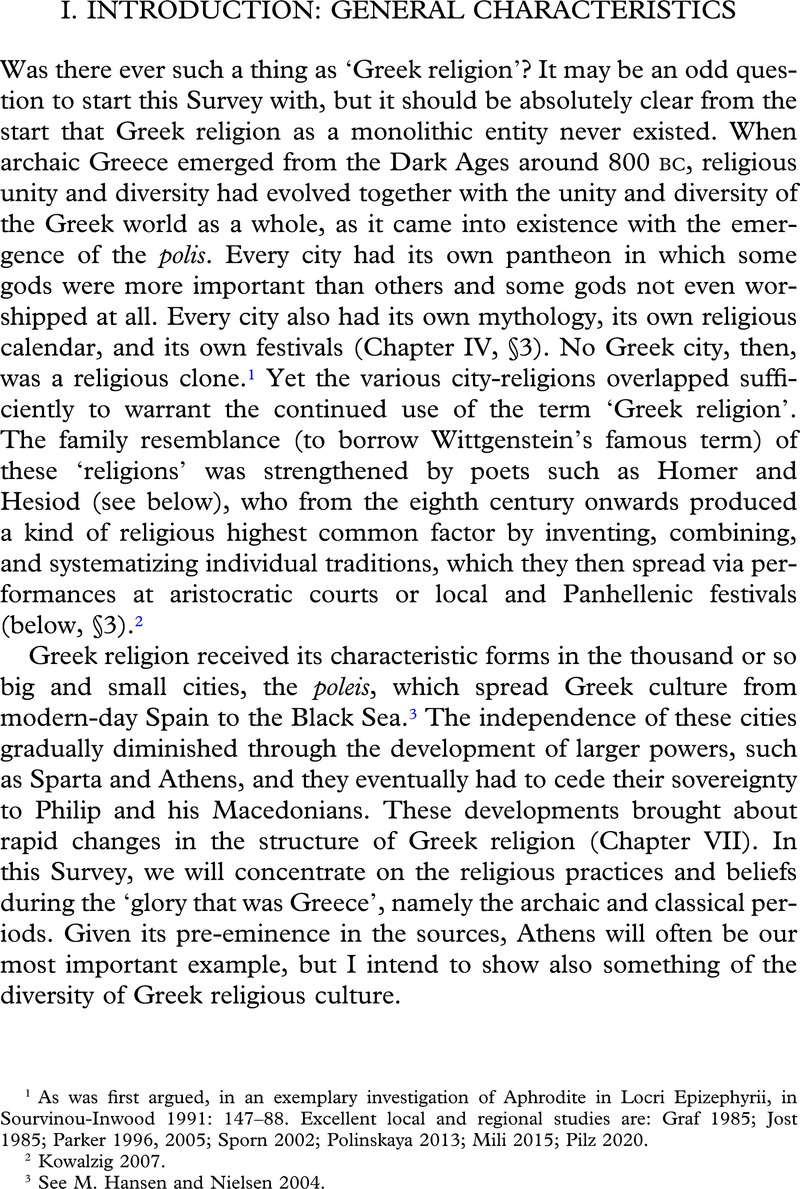No CrossRef data available.
Article contents
I. Introduction: General Characteristics
Published online by Cambridge University Press: 19 March 2021
Abstract

- Type
- Introduction
- Information
- Copyright
- Copyright © The Classical Association 2021
References
1 As was first argued, in an exemplary investigation of Aphrodite in Locri Epizephyrii, in Sourvinou-Inwood 1991: 147–88. Excellent local and regional studies are: Graf 1985; Jost 1985; Parker 1996, 2005; Sporn 2002; Polinskaya 2013; Mili 2015; Pilz 2020.
2 Kowalzig 2007.
3 See M. Hansen and Nielsen 2004.
4 See T. Smith 2021.
5 Bruit Zaidman and Schmitt Pantel 1992: 158.
6 The terminology derives from the economist Karl Polanyi (1886–1964); see Gemici 2008. It was applied to Greece in Parker 1986: 265, unconvincingly rejected by Nongbri 2008. See also Kindt 2012: 16–19.
7 Attention to the role of the senses in Greek religion has become more important in recent times. For smell, see Mehl 2018.
8 See Bremmer 1998; Feil 1986–2012.
9 Harrison 2002; Burkert 2001–11: vol. 7.
10 Bremmer 2007, 2015.
11 G. Martin 2009: 104–15 (Aeschines); Kindt 2015.
12 Wijma 2014.
13 Fischer 2017.
14 Jacoby on FGrH 596 F 46; Bremmer 1993.
15 On priesthoods, see Lambert 2010; Horster and Klöckner 2012. On Athens/Athena, see Smarczyk 1990, to be read with Tuplin 1999; Parker 1994; Jameson 2014: 232–69.
16 So, strikingly, Burkert 1985: 269; see also Parker 1983: 151f.
17 Parker 1983: 328–31; Parker 2011: 148f.
18 For this process, which is in need of further analysis, see Bremmer 2019e: 89–93, 106.
19 For the vocabulary of the sacred, see Parker 1983: 147–50; Motte 1986; Nuchelmans 1989; Rudhardt 1992: 231–52.
20 Peels 2016: 255f.
21 Peels 2016: 27–67.
22 See the discussion of recent scholarship on hiera kai hosia in Peels 2016: 225–30.
23 So Parker 1983: 153 (also for garlands).
24 Alroth 1989: 64–105, reviewed in van Straten 1992.
25 For pistis, see Bontempi 2013. On conversion, see Bøgh 2014; Bremmer 2016.
26 Gladigow 2005: 138–48.
27 For a discussion of the notion ‘loving god (God)’, which ranges from classical times to the early Christian period, see Söding1992.
28 See the illuminating analysis, based on a statistical comparison, in Peels 2016: 68–106.
29 Vicente Sánchez 2015; Eidinow 2016: 48–62; Naiden 2016.
30 For the full evidence, see Filonik 2013 and 2016.
31 For the much-discussed case of Socrates, see, most recently, Karavas 2018; Bremmer 2020c: 1016–20.
32 On visits, see Flückiger-Guggenheim 1984.
33 For Oedipus, see Bremmer 1990a. For the Spartans, see Hdt. 1.128; also Parker 1983: 184. In general, see Speyer 1989: 254–63.
34 Oudemans and Lardinois 1987.
36 Van der Horst 1994: 165–202; Henrichs 2019: 299–334.
37 Gould 2001: 203–34; Buxton 2013: 161–72 (bafflement).
38 Nesselrath 2020.
39 For the development of beliefs and attitudes regarding death, see Sourvinou-Inwood 1995; Scholl 2007; E. Giudice 2015; Schlatter 2018; Mackin Roberts 2020.
40 For books, see Parker 2011: 16–20. For children, see Prescendi 2010; Auffarth 2012.
41 Contra Versnel 2011: 539–59 and see also Harrison 2015; Bremmer 2020e. For early Christianity, see T. Morgan 2015; Frey et al. 2017.
42 Eidinow et al. 2016, to be read with Bonnet 2017.
43 See Bremer 1991; Weber 1992.
44 For the idea of a separate language of the gods, which goes back to Indo-European times, see M. West 2007: 160–2; Willi 2009: 247–9; this volume, Chapter II, §1.
45 See, most recently, Rutherford 2018.
46 See Burkert 1992: 89–93 and 2004: 30–1. See also Currie 2016: 204; Yakubovich 2017: 365 (with further linguistic arguments); this volume, Appendix.
47 Flower 2008; S. Johnston 2008: 109–43; Naerebout and Beerden 2012; Trampedach 2015; Foster 2018; Bremmer 2019e: 147–64; Van Hove 2019. For a comparison with the ancient Near East, see Beerden 2013; Nissinen 2017.
48 Sourvinou-Inwood 2000.
49 See especially Rüpke 2011; Kindt 2012: 12–35; Bremmer 2019e: 125–46. But see also the spirited defence of Parker 2018b.
50 See Boedeker 2008; Faraone 2008.
51 On outposts, see Demetriou 2017; Bremmer 2019e: xii; Lemos and Tsingarida 2019. On the periphery, see Scholl 2018.
52 On accepting new gods, see Garland 1992; Auffarth 1995; Parker 2011: 273–7.




